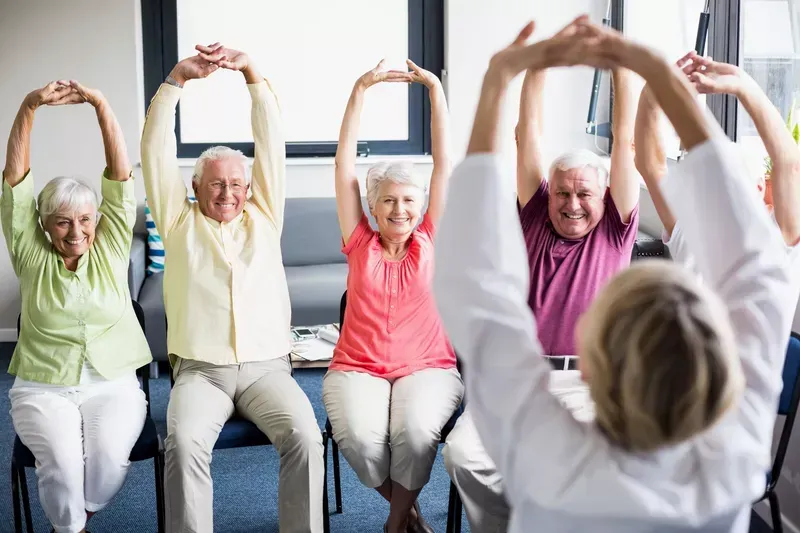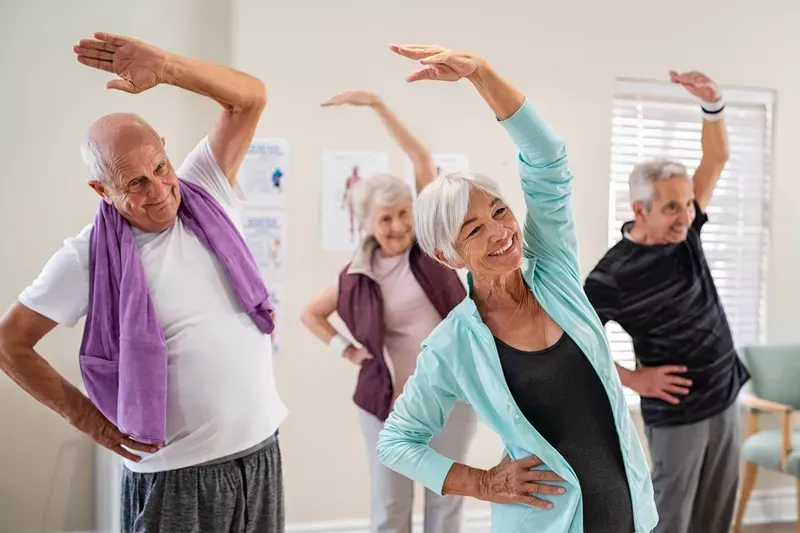BLOG
Staying Active in Assisted Living: Fun and Engaging Exercise Programs for Seniors
Maintaining an active lifestyle is essential for seniors' overall health and well-being. Regular physical activity enhances mobility, boosts mood, and reduces the risk of chronic diseases. In assisted living communities, structured exercise programs promote residents' physical and mental health. These programs are tailored to accommodate varying fitness levels, ensuring inclusivity and safety for all participants.
Assisted living facilities recognize the importance of offering diverse and engaging exercise options. By providing a range of activities, the program allows residents to find programs that align with their interests and abilities. This personalized approach fosters a sense of autonomy and encourages consistent participation. Moreover, group exercise sessions enhance social connections, contributing to a supportive community environment.
Why Exercise Programs Are Important in Assisted Living
Regular exercise is vital for seniors to maintain independence and prevent health decline. Physical activity improves cardiovascular health, strengthens muscles, and enhances flexibility. According to the Centers for Disease Control and Prevention (CDC), adults aged 65 and older should engage in at least 150 minutes of moderate-intensity aerobic activity per week. Meeting these guidelines can significantly reduce the risk of heart disease, diabetes, and certain cancers.
Structured exercise programs are designed to meet these recommendations in assisted living settings. These programs offer a variety of activities, from aerobic classes to strength training, ensuring residents can choose exercises they enjoy. Regular physical activity can improve balance and coordination in seniors, reducing the likelihood of falls. Additionally, exercise has been linked to enhanced cognitive function, aiding in memory retention and mental clarity.
Beyond physical benefits, exercise programs contribute to emotional well-being. Group activities foster social interaction, combating feelings of loneliness and isolation. The sense of community and shared goals can lead to increased motivation and adherence to fitness routines. Assisted living communities prioritize creating an environment where residents feel encouraged and supported in their wellness journeys.
Furthermore, tailored exercise programs can accommodate individuals with chronic conditions or mobility limitations. Certified fitness instructors modify activities to ensure safety and accessibility for all participants. This inclusivity empowers residents to take charge of their health, regardless of physical limitations. Personalized fitness plans can address specific health concerns and improve quality of life.
Types of Exercise Programs Beneficial for Seniors
Various exercise programs cater to seniors' unique needs and promote comprehensive health benefits. Aerobic activities, such as walking clubs or low-impact dance classes, improve cardiovascular endurance. These activities elevate heart rate safely, enhancing blood circulation and respiratory efficiency. Regular participation can lead to increased stamina and energy levels.
Strength training exercises are crucial for maintaining muscle mass and bone density. Seniors can safely build strength by using resistance bands, light weights, or body-weight exercises. The National Institute on Aging emphasizes that strength training helps reduce the risk of osteoporosis and enhances functional abilities. Improved muscle strength supports daily activities and fosters greater independence.

Flexibility and balance exercises, including yoga and tai chi, enhance range of motion and stability. These practices focus on gentle stretching and controlled movements, reducing stiffness and improving posture. Enhanced balance decreases the risk of falls, a common concern among older adults. Incorporating these exercises into routine programs contributes to overall physical confidence.
Mind-body exercises, such as meditation and deep breathing techniques, address mental and emotional health. These practices reduce stress and anxiety and promote relaxation. Integrating mind-body exercises into fitness programs supports holistic well-being. Assisted living facilities often offer dedicated spaces for residents to engage in these calming activities.
Tailoring Exercise Programs to Individual Needs
Personalized exercise plans are essential to accommodate seniors' diverse abilities and health conditions. Fitness professionals conduct initial assessments to help determine each resident's fitness level and identify any limitations. Understanding individual health backgrounds allows for creating safe and effective exercise routines. This personalized approach ensures residents receive appropriate challenges without overexertion.
For residents with mobility issues, seated or chair-based exercises provide accessible fitness options. Programs like "Sit and Be Fit" focus on toning and stretching from a seated position, which benefits individuals with physical restrictions.
Chronic conditions, such as arthritis or cardiovascular disease, require specialized exercise modifications. Low-impact activities and gentle movements can alleviate symptoms and improve overall health. For instance, tai chi has been shown to reduce arthritis pain and increase joint flexibility. Collaborating with healthcare providers ensures exercise plans align with medical recommendations.
Cognitive impairments, including dementia, necessitate structured and straightforward exercise routines. Repetitive movements and clear instructions aid in comprehension and participation. Group activities with familiar music or rhythms can stimulate cognitive function and provide enjoyment. Consistency and patience are key in facilitating successful engagement for these residents.
Regular evaluations and feedback allow for adjustments to exercise programs as residents' needs evolve. Monitoring progress and soliciting resident input ensures the activities remain effective and enjoyable. Flexibility in programming reflects a commitment to resident-centered care. This dynamic approach fosters sustained participation and continuous health benefits.
Social Benefits of Group Exercise Activities
Group exercise activities offer significant social advantages, fostering a sense of community among residents. Participating in group classes encourages social interaction, reducing feelings of isolation. Shared experiences in fitness sessions build camaraderie and friendships. This social support system enhances emotional well-being and contributes to a positive living environment.
Collaborative activities like dance classes combine physical exercise with social engagement. Programs like Latin dance have been shown to improve mood and cognitive function in seniors. Dance’s joyful nature fosters both physical health and social connection.

Group exercises also introduce an element of accountability and motivation. Residents are more likely to attend sessions regularly when they know their peers are participating. This collective encouragement fosters a culture of wellness and commitment to health goals. The routine of attending classes together strengthens the community bond.
Social engagement through exercise extends beyond scheduled classes. Residents often continue interactions informally, organizing walking groups or recreational sports. These spontaneous activities further enrich social networks and promote active lifestyles. Assisted living communities support these initiatives by providing accessible spaces and resources.
Incorporating family and friends into group exercise events enhances the support system. Hosting open classes or fitness demonstrations allows loved ones to participate, strengthening relationships. This inclusivity reinforces the importance of physical activity and community involvement. It also gives families insight into the residents' daily lives and well-being.
Creating a Culture of Wellness in Assisted Living
Fostering a culture of wellness in assisted living communities requires a commitment to physical, mental, and social well-being. Staff members play a key role in promoting and supporting exercise programs. Trained professionals guide residents through safe and effective activities while ensuring inclusivity. Their encouragement helps build confidence and fosters long-term engagement in physical activity.
Incorporating wellness into daily routines makes exercise a natural part of life. Facilities can integrate movement-based activities into social events and recreational programs. Walking meetings, dance nights, and stretching sessions before meals encourage participation. These small adjustments help residents stay active without feeling pressured to join formal fitness classes.
Access to proper fitness equipment and safe exercise spaces enhances participation. Communities should offer well-maintained workout areas, pools, and outdoor walking paths. Providing adaptive equipment for residents with mobility limitations ensures equal opportunities. Thoughtful facility design contributes to an environment where movement feels accessible and enjoyable.
Encouraging goal setting and progress tracking can boost motivation. Residents who see measurable improvements in their strength, endurance, or flexibility are more likely to continue exercising. Celebrating milestones with group recognition or wellness awards reinforces a sense of achievement. Tracking progress also helps staff adjust programs to meet individual needs.
A culture of wellness extends beyond structured programs to promote holistic health. Nutrition, mental well-being, and social connection complement physical activity. Assisted living communities that prioritize comprehensive wellness create vibrant, engaged environments. This commitment helps residents maintain independence and enjoy a higher quality of life.
Stay Active in Assisted Living
Staying active in assisted living enhances physical health, mental well-being, and social engagement. Exercise programs provide structured opportunities for residents to improve mobility, strength, and balance. Group activities encourage social interaction and foster a sense of community.
At Assured Senior Living, residents can access tailored exercise programs to promote well-being in a safe and engaging environment. Our team prioritizes personalized care, ensuring every resident finds activities that suit their abilities and interests. Discover how our approach to senior wellness can enhance your loved one's quality of life. Contact us today to learn more about our programs and schedule a visit.














